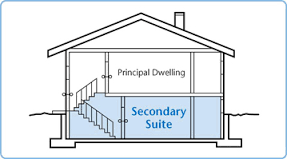 Buying a home with a secondary income suite, or with the intention of installing one, can be an effective way to offset steep mortgage costs in some of the hottest Canadian real estate markets.
Buying a home with a secondary income suite, or with the intention of installing one, can be an effective way to offset steep mortgage costs in some of the hottest Canadian real estate markets.
And it should come as no surprise that they’ve become a widespread practice in Toronto and Vancouver, where the average price for a detached home now exceeds $1 million.
Considering rental vacancies are incredibly low in both cities – 1.6 per cent in Toronto, and 0.6 per cent in Vancouver – offering affordable housing seems like a guaranteed money maker. In fact, 80 per cent of rental units outside of purpose-built developments are located in private residences.
The Canada Mortgage and Housing Corporation (CMHC) recently recognized how secondary suites help alleviate the affordable housing crunch in Canada, and has introduced new regulations to make them more affordable than ever; as of July 2015, 100 per cent of rental income from a suite can be factored into a mortgage qualification.
“Secondary rental suites are recognized as a source of affordable housing offered at a cost that is often lower than those for apartments in purpose built rental buildings,” states the Crown Corporation.
But building and maintaining a secondary income suite – not to mention assuming the role of landlord – isn’t a simple task. And while there are a number of resources available, it’s up to newbie landlords to understand their legal responsibilities, or face the financial consequences.
Here are the top challenges would-be landlords should consider before making the plunge.
 1. Make it legal
1. Make it legal
There are a number of regulations, safety codes and bylaws that must be adhered to in order to have a secondary suite. This means you’ll be on the hook for any required fees, permits and inspections if you’re building your suite from scratch. If you’re purchasing a home with a secondary suite included, there’s the chance it may not be up to code and will need to be retrofitted.
While it may be tempting to skip all of the legal legwork and operate your suite under the radar, doing so puts you at risk for huge financial penalties if you’re caught. Anyone can call in an inspection to the city and you could be forced to remove any work done and convert the home back into a single-family dwelling. You will also be liable in case of accident or death of an unreported tenant, and could even void your own home insurance coverage.
According to the Second Suites Guide prepared by the Ontario Provincial Government, a secondary suite must include the following to be legal:
- The residence must be at least five years old
- The house must be detached or semi-detached (different regulations exist for adding suites to rowhomes)
- The exterior of the home cannot be significantly altered
- The secondary suite cannot be larger than the rest of the home
- It must have its own separate entrance, bathroom, kitchen and living facilities
- It must be up to fire code, have a minimum 15-minute fire rating, and at least two escape routes, one of which must be a door leading to the outside
- It must meet municipality parking requirements
The CMHC has additional requirements for those looking to use their suite to qualify:
- The residence must be owner-occupied
- The home can only have two dwelling units (the primary unit and the secondary suite)
- Existing suites must have two years’ worth of rental history
- The suite must have legal status
2. Obtain the right permits
 Many homebuyers make the mistake of assuming they can build or expand an income suite in their home without researching the required permits. According to the Second Suite Guide, formal permission is required to make any significant structural changes to your home.
Many homebuyers make the mistake of assuming they can build or expand an income suite in their home without researching the required permits. According to the Second Suite Guide, formal permission is required to make any significant structural changes to your home.
“If you start construction but do not have the necessary permits, you may be ordered to stop work, prosecuted, and even ordered to remove work already done. If you are uncertain as to whether you need a permit for your project, contact your local civic centre directly,” it states.
A permit is required in order to:
- renovate, repair or add to a building
- demolish or remove all or a portion of a building
- change a building’s use
- install, change or remove partitions and load-bearing walls
- make new openings for, or change the size of, doors and windows
- build a garage, balcony or deck
- excavate a basement or construct a foundation
- install or modify heating, plumbing, air conditioning systems or fireplaces
3. Know your responsibilities as a landlord
Being a landlord is no easy task – you’ll be required to handle every aspect of the suite, including marketing it and selecting prospective tenants, collecting the rent, and maintaining the property. Your responsibilities and your tenants’ rights will be governed by Tenant Protection Act in your province. It’s important to review the Act in depth, but it generally covers:
- You have the right to collect rent on time, to not have your property damaged, and to not be harassed or disturbed by your tenant.
- Your tenant has the right of security of tenure, meaning, they can occupy the suite until there are valid, proven grounds for eviction – even during an ongoing dispute.
- Your tenant has the right to live in a suite that is habitable, safe and properly maintained
- Your tenant has the right to reasonable enjoyment, meaning they can have overnight guests, cook foods of their choice, and come and go as they please.
© http://www.whichmortgage.ca/article/3-tips-for-secondary-income-suites-213549.aspx
